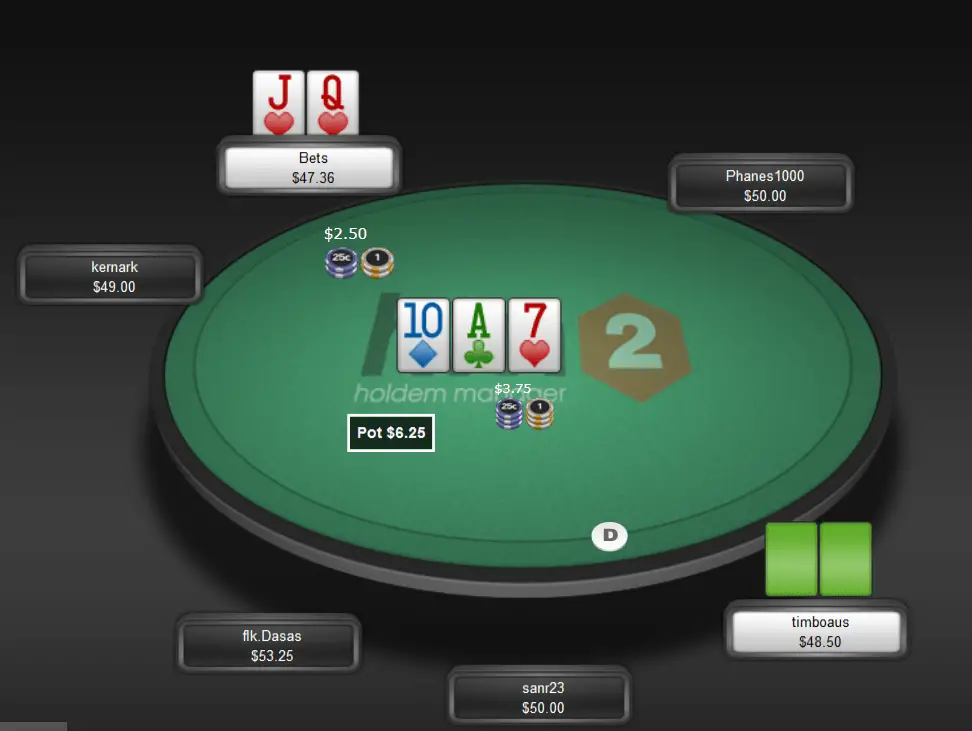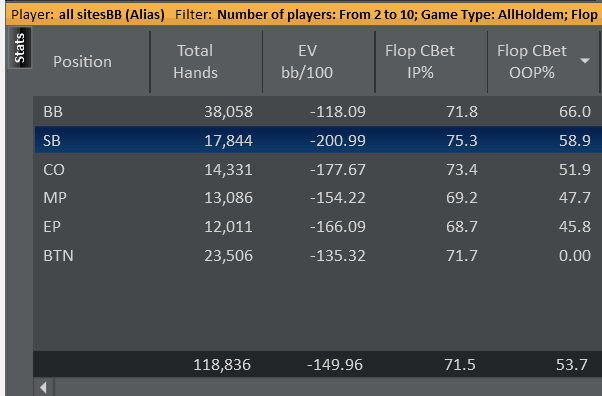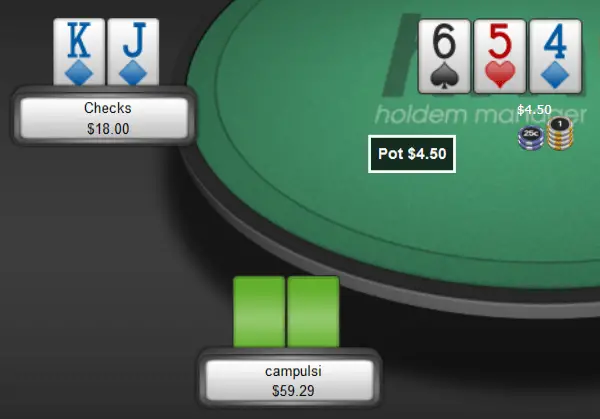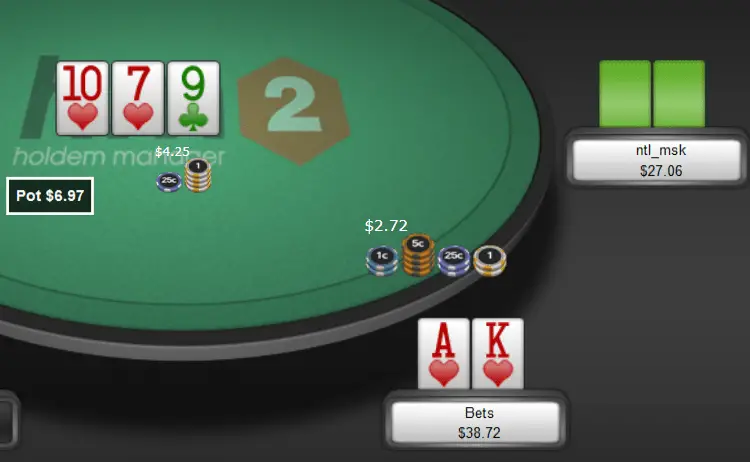What to do if You Miss the Flop?
Everyone can make print money on the flop with made hands. But did you ever wonder if it is possible to make money when you miss the flop in poker? For your bets to be successful on the flop, you need to do more than placing the bet.

When you miss a flop you have 3 options to consider:
- You can make a bet and hope that opponents will fold or you can give up
- You can check if it is checked to you
- You can fold or call or raise if someone else has bet, although you shouldn’t raise.
You can make money in poker by making a bet on the missed flop. After all, aggression is what makes you money in poker. Your winnings won’t come solely from the aggression, though.
You need to find the right spots for when to bet. It is also essential to bluff against the right opponents. Sometimes it is good to bet while at other times it is best to give up. This article will answer all the questions you have about how to play when you have nothing on the flop.
How to play a flop in poker that you have missed? The optimal strategy for the missed flop depends on many different factors, let’s look at them below.
1. Correctly Applied Aggression in Poker is Key
The purpose of betting is to force opponents with better hands to fold. That way, we win the pot. Against unknown players, with no reads, we shouldn’t be barreling (betting) all 3 streets when we have 0 equity and no blockers. Always try to have at least some equity if you decide to bluff.
Having a good strategy for all the times when you miss the flop is vital. You will only hit a pair or better on the flop about one-third of the time. Other times you will need to make an important decision if you want to try and pick up the pot or check and hope for a free turn card.
We need to show aggression in carefully chosen spots. This is where studying the game and having a well-structured plan comes into play. In Nolimit Holdem, a thinking player who studied the game will win in the long term. All the small decisions will add up. And a portion of those is applying the aggression when it makes sense. Do not automatically bet on the flop. Each bet needs to have a purpose behind it.

On dry poker flops your general post flop strategy should be to bet, since the opponent also most likely missed the flop. The person who had aggression preflop or the person who first shows aggression post-flop is likely to take the pot down.
2. Position Matters
It is much easier to apply pressure when you have the position. I bet a lot more in position than out of position. We have a much easier decision with our weak hands when we are last to act. We can even decide to take the free card if we desire so.
In position
Betting even against 2 opponents in position can be fine if the flop is favorable for our range. You need to start thinking in terms of ranges and not about our actual hand. Then apply the same strategy for hands in our range. So if we raise preflop in early position, then a lot of our range will be high pairs and good ace-high hands. Therefore on flops that bring an ace, we can start betting more, even if we missed the flop.
All poker pros think in terms of ranges, and once you begin to do the same, your understanding of the game will go on another level. This free educational website caused me to bring my own game to a higher level, and I can’t praise it enough, as it turned me into winning poker in a very short time.
Out of position
Out of position, we can’t afford to bluff that much, and we need to be more selective on which flops we try to take the flops down. A and K high cards with 2 low disconnected cards are good to cbet even out of position against a single opponent. But generally, we will make a continuation bet on the flop less often when playing out of position. It is simply better to fold complete air on flops that aren’t the best for our range.

Look at how often I bet when I don’t have at least a pair on the flop. And compare it to when I am in a position with air. I go for a bluff much more often. 71% of the time in position vs. 53% out of the position. It is true I am losing while I do this. But I loose less if I would have given up. I already have 3 big blinds invested in the pot. Therefore my winrate for giving up would be -300bb/100 (300 big blinds per 100 hands) and now it is only around -150bb/100.
3. Bet Sizings when Bluffing
You will want to stick to the same bet sizings when bluffing as you would with value bets. This is something many observant opponents will catch on quickly if you don’t do it correctly.
If you have 2 different web sizings when value betting. Then now you should have the same 2 different bet sizings for your bluffs. This way, we will keep our opponents guessing if we have the hand or we are bluffing.
More draws the flop brings bigger you will want to make your bet if you decide to try. If we have a draw, we should bet bigger as we don’t have a made hand yet, and we want to increase the likelihood the opponent will fold as we don’t want to see a call. It is also vital that on such flops, we don’t bet with complete air. At least have a weak draw yourself, like a weak flush draw or bottom open-ended straight draw.
If you are starting, then having two bet sizings is enough:
- Betting half the pot on very dry boards, like A26, K38 with different suits
- 2/3 up to ¾ of the pot on flops that have some draws present
4. Adapt to the opponents
Once we have a read that the opponent is folding a lot, then cbet more. I know it is close to impossible to track exactly how much each opponent is folding. This is where hand tracking tools like HM2 and their powerful HUD’s come into play. Every poker pro is using them for a reason. Against an unknown player, you should stick to the default strategy we have covered so far.
When to bluff against unknowns
When you don’t have any reads yet, consider this: don’t inflate the pot with bluffs. This gets very costly fast, and it destroys your winrate. Mistakes on the flop will compound, and before you know it, you are faced with a river decision whether you should make a bluff for 50 big blinds or not. Wasting 50 big blinds will take you 2h of playing to win back if you are an excellent winner while playing 6 tables!
If on the flop you have a hand that can still improve, for example, a flush draw or open-ended straight draw or a semi draw, gutshot, overcards, those are an excellent choice to be more inclined to bluff with. Don’t bluff against multiple opponents.
Bluff only against players that are capable of folding. On micro stakes, there is plenty of players that don’t like to fold and will call to see another card. So you should keep pure bluffing there to a minimum until you get further reads.
Bluffing also needs to make sense. You need to represent a strong hand well. Flops also need to hit your preflop range. Not many players, even on microstakes, will believe you otherwise.
For example, don’t represent a straight on 456, if you raised in an early position. 23, 47 and 87 aren’t part of your preflop opening range.

When to bluff more
Simple math, combined with sufficient hand data, works to your advantage in poker. Every poker pro uses a HUD. This gives us exact opponent stats once we have enough hands on a particular opponent. It makes playing for me much simpler and more effortless in many spots. On lower limits, there will be many players who either call too much or fold too often. Let us focus on the opponents that fold too often first. For example, you make cbet on the flop of ½ of the pot, and our opponent folds more than 50% of the time to bets on the flop.
In the pot on the flop it is 10 chips, and we bet 5 chips in order to win 10 chips. If we get a fold more then 50% of the time we win, we will lose 5 chips less often that we win 10 chips. This way, we make an immediate profit from the bet.
This is all part of the standard poker math that every serious player learns. It is free money as long as the opponent doesn’t adapt. And in micro stakes, not many players will adjust correctly, so we can keep exploiting them. This is usually very straight forward and weak players. And they are great customers if you want to make consistent small profits.
Even more, if you keep being aggressive with bets vs. them on the flop, they might eventually get titled and make a hero call against you, when you hold the nuts.
Betting less often
You should be betting less when:
- An opponent is a calling station. Usually on microstakes players will not be able to fold anything at all. If if they have just a backdoor draw, it is good enough for them to justify the call. Against such players, there is no point in bluffing. Just wait that you get a good enough hand and value bet on multiple streets. You will make more money by them calling you with incorrect odds than by betting when you have nothing.
- Playing against several players; If you are up against 2 or more players, then the percentage of your bet should go down, and bluffing with air is not advised. Someone has likely hit a piece of the board.
- The opponent is aggressive and check-raises a lot. This is another example of them having a HUD will help you a lot. Tools like Holdem Manager 2 and now even HM3 will measure player’s aggression on each street. They will also give you the exact percentage of how often someone check-raises. But to show close to real check-raise percentages, you will need to have at least 1000 hands on the opponent.
Players who are aggressive and like to check-raise a lot don’t fold much on flops. Taking a free card and hoping to hit something decent on the turn is your best bet. Don’t inflate the pot with your bluffs and marginal hands. This will give a better incentive to the aggressive opponent to try and steal the pot from you.
Focus on getting a strong hand first and then bet. Such players will often continue showing aggression on turn and river against you with whatever they have. Then you can call them down and pick up a massive pot with your strong hand.
5. Good Flops to Bluff
Best flops to bluff are very dry ones and when we are in the position. A classic example of this is Ace high flops with 2 low disconnected cards on the flop give example A28o). If I am on the button, then my cbet size on such board is half pot, and I am betting close to 100% of the time.
Sometimes I make a continuation bet of less than half pot. I might go as low as 30% of the pot. If I get called, I can give up on later streets. I know I made the correct decision by betting small and long term I am losing less with a bet than giving up.

Good examples of dry flops on which it is good to bluff are:
- Ace high rainbow boards with 2 low disconnected cards, like A28 offsuit mentioned above already.
- Paired boards
- Ace and 1 more broadway and 1 low card – example hand AK8 rainbow
- Other combinations of one broadway and 2 lower disconnected rainbow flops – example K28r, or Q37r
- When playing heads up, you should be me more inclined to make the flop bet with air

6. Bad Flops to Bluff on
Flops, where many draws are possible, are bad candidates to bluff on even when playing heads up. It is more likely that the opponent has at least a draw and will not be folding on the flop often enough for us to make a profitable bet.
Examples of draw heavy boards:
- JT8 with FD. This is extremely draw heavy board. Don’t bluff on this one.
- QJ6 with FD,
- T97 rainbow. It is not the best idea to be betting on this flop. Even though it’s rainbow, you will not see that many flops.

As you can see, drawy boards are usually the ones that bring possibility of an open-ended straight draw and/or flush draw. On such flops, even as the aggressor, the best move is to give up with nothing. It doesn’t make sense to bluff if the opponent is not likely to miss this board, and he is not folding.
If the flop is multiway, then you need to bluff less. If you want to win at poker in most cases when up against 3 opponents, I would never bluff. Move on and wait for a better opportunity.
7. Giving Up is Fine
Giving up is acceptable. In fact, often, the correct way to play a missed flop is to give up. You lose only your preflop investment. You made the correct move preflop by opening the right hand, and now you will make the correct move by giving up.
Poker is a great game where all the correct small decisions pile up, and that is what eventually makes you a better player. Don’t get frustrated if you keep missing flop after flop. Your time will come when you will hit the flop hard. On the other hand, if you keep hitting flops well, don’t expect it to last. Just focus on making the correct decision every time.
If you are still unsure what right choice often is, then join a free poker coaching site, like this one. And later, when you are a bit better, get yourself a coach or join a paid coaching website.
8. Playing Missed Flop When Calling Preflop
If you are the aggressor preflop, then all of the written above will apply to you. But what to do if you have called a preflop bet?
This will most often either occur in cutoff or button and in the big blind. Good players don’t call a lot in SB. They prefer 3betting or folding.
If you decide to call preflop and are out of position postflop, your only option is to play straightforward.
If you have the position, then you have a few more options on the flop. If it gets checked to you and board is good for your preflop calling range, then it is good to make a bet and try to take the pot down. This is another spot where having a HUD makes you money. In this scenario, I would have a look at how often a player folds when he doesn’t make a continuation bet on the flop. I hope you are starting to see how helpful hand tracking software and the HUDs are. This is a read on an opponent that is very hard to pick up on your own if you are multi-tabling.
Sometimes I might even consider raising opponents bet if I see he bets too much on the flop and flop is somewhat good for me. I prefer to take the pot down now on the flop than keep calling opponent’s bets with just a draw. For this, I would help myself again with the HUD stats.
9. How to Play Draws

To play draws correctly, you first need to understand the math behind them. It is not a good idea to call strong, pot-sized bets with a weak draw.
In a very simplistic way: if you called preflop, then you should play your draws passively. You can call moderate flop bets, but calling pot bets is too much unless you have a nut flush draw. With other flush draws and oesd call only the moderate flop bets. With draws weaker than this, just go ahead and fold.
If you raised preflop, then you can play your draw aggressively by cbetting on the flop as long as you are up against one or max 2 opponents. Playing a draw aggressively still only makes sense when we know that the opponent is capable of folding.
If a calling machine calls you down with 2nd pair when you kept betting all 3 streets with your nut flush draw, then the mistake is on you to inflate the pot, not on him to call you. Players do what they think is best. No point in trying to change their mind. Adapting to other player playstyle is a crucial skill you also need to master if you were to become a successful poker player yourself.
Conclusion
Now you know what to do if you miss the flop. Always follow your overall strategic plan. And do not bet on the flop automatically, but look for a reason why it might be good to bet.
Either opponents folding too much, flop hitting our range, or us holding a decent draw and believing we can get a better hand to fold. It is on you to decide. Stick to helpful tools that will give you enough information to make a correct decision.
See you at the tables!



